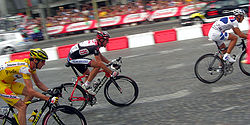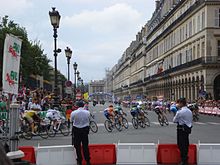- Champs-Élysées stage in the Tour de France
-
The Tour de France has finished on the Champs-Élysées every year since 1975. In the first edition of 1903, the finish was at Ville d'Avray; from 1904 to 1967 in Parc des Princes track and from 1968 to 1974 at the Vélodrome de Vincennes track.
Contents
History
In the first edition of 1903, the finish was at Ville d'Avray; from 1904 to 1967 in Parc des Princes track and from 1968 to 1974 at the Vélodrome de Vincennes track.[1]
Until 1967, the Tour ended with the former Velodrome Parc des Princes. Between 1968 and 1974 during the heyday of Eddy Merckx the finish was at the velodrome Cipale in Bois de Vincennes. That year, Felix Levitan, co-director of the Tour and Yves Mourousi, the star reporter of suggested a finish on the Champs-Élysées.
Mourousi directly contacted French President Valéry Giscard d'Estaing to obtain agreement.[2] The first step was to take place in 1975: this is a step in line Paris-Paris 25 laps (163.5 km in cash on departure). The Belgian Walter Godefroot won the sprint and Bernard Thevenet can receive the yellow jersey from the hands of Valéry Giscard d'Estaing. In 1976 and 1977, a cons-trial of a lap is in the morning, followed the step in line 14 laps (91 km) in the afternoon. In 1977, French Alain Meslet becomes the first rider to win alone. From 1978, the Tour launched from outside the city. Since that date, only the end of the stage follows the route, and the number of laps varies between six and eight, except for 2003, when the Tour commemorated the centenary of the event by having riders complete 10 laps of the circuit.
Arrivals
Due to the high profile of the last day, the stage is prestigious. The overall Tour placings are typically settled before the final stage so the racing is often for the glory of finishing the Tour and, at times, to settle the points classification.
Traditionally, the stage starts with champagne served by the race leader's team, on the road photo-opportunities and joking around. As the riders approach Paris, the racing heats up as the sprinters and their teams begin the real racing of the day. When the riders reach central Paris, they enter the Champs-Élysées riding up the Rue de Rivoli, on to the Place de la Concorde and then swing right on to the Champs-Élysées itself. The riders ride now a total of 8 laps (up towards the Arc de Triomphe, down the Champs-Élysées, round les Tuileries and the Louvre and across the Place de la Concorde back to the Champs-Élysées). In past Tours, the riders would complete ten laps before the Tour was over.
General classification
There are a few exceptions, in which the last stage saw attacks on the leading position in the general classification.
1979
In 1979, Joop Zoetemelk was 3:07 behind Bernard Hinault before the final stage. Zoetemelk attacked on the last stage, hoping to win enough time to claim the victory. Hinault chased Zoetemelk, and beat him for the stage victory.[3]
1989
In 1989, Greg LeMond beat Laurent Fignon by 58 seconds over a 24 km time trial from Versailles. In doing so, he closed a 50-second gap to win the 1989 Tour de France by eight seconds. It was the first time trial final stage on the Champs-Élysées. The 1964, 1965 and 1967 Tours finished with time trials to the [[Partime trials to the Vélodrome de Vincennes (Cipale).
2005
In 2005, Lance Armstrong had a comfortable lead in the general classification, but behind him Alexander Vinokourov and Levi Leipheimer were only two seconds apart, on fifth and sixth place. Vinokourov succeeded in a breakaway during the last kilometre and, because of his stage win and bonus seconds, overtook Leipheimer for fifth position overall.[4]
Points classification
In some years, the points classification was decided on that last stage.
1984
In 1984, Frank Hoste had been leading the points classification for most of the race, but Sean Kelly had taken over the lead on the penultimate stage, with a difference of 4 points. Hoste ended third in the last stage against Kelly fifth, which made Hoste the winner by 4 points.
1987
In the final stages of the 1987 Tour de France, the lead in the points classification switched between Jean-Paul van Poppel and Stephen Roche. Before the final stage, Roche was leading by 17 points, but during the last stage Van Poppel won back 16 points by intermediate sprints. Van Poppel's ninth place in the stage was then enough to win the points classification by 16 points.
1991
In 1991, Djamolidine Abdoujaparov clipped his wheels on barriers. With less than 100m left he tumbled head-over-heels in a spectacular crash. After he regained consciousness, he was helped across the line to clinch the sprinters' competition.[5]
2001
In 2001, Stuart O'Grady had been leading the points classification for most of the race, but Erik Zabel overtook him at the final moment.[6]
2003
In 2003, the green jersey was settled by a close finish between Baden Cooke and Robbie McEwen finishing 2nd and 3rd respectively, this meant that Baden Cooke finished with 216 points to Robbie McEwen's 214.
Winners
References
- ^ Augendre, Jacques (2009). "Guide Historique" (in French). Amaury Sport Organisation. p. 179. http://www.letour.fr/2009/TDF/COURSE/docs/histo2009_07.pdf. Retrieved 15 February 2010.
- ^ Supplement Team 1410 of July 25, 2009. Confirmed by Raphael Geminiani on the issue of Big Heads of June 14, 2010.
- ^ McGann, Bill; McGann, Carol (2008). The Story of the Tour De France: 1965–2007. Dog Ear Publishing. p. 137. ISBN 1-59858-608-4. http://books.google.nl/books?id=V8mlwItBhhcC&pg=PA137.
- ^ Suddenly seven
- ^ McGann, Bill; McGann, Carol (2008). The Story of the Tour De France: 1965–2007. Dog Ear Publishing. p. 201. ISBN 1-59858-608-4. http://books.google.nl/books?id=V8mlwItBhhcC&pg=PA201.
- ^ Zabel bags the green in exciting finale
- ^ "Memoire du cyclisme" (in French). http://memoire-du-cyclisme.net. Retrieved 15 February 2010.
Wikimedia Foundation. 2010.



